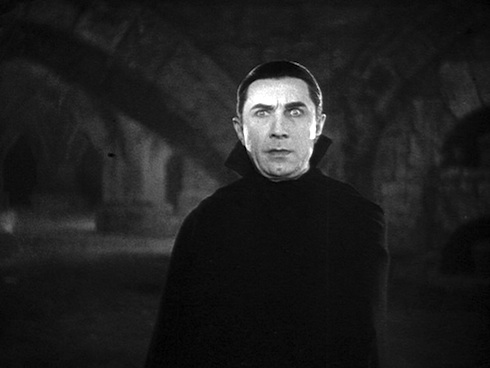While re-watching several classic monster movies, I’ve started to believe monsters occupy a very similar niche normally reserved for superheroes. The films are centrally about a monster’s “powers” which usually, informs most, if not all, of the narrative. In terms of super powers, Bela Lugosi’s incarnation of Count Dracula has them coming out of his ears: shape shifting, mind control, immortality, flight, invisibility, blood-sucking, real estate negotiation skills…I could go on.
What makes Dracula such an enjoyable film is not only the inherent coolness of the powers, but also the slick way Dracula gets things done. Of all the monsters, vampires are usually considered the sexiest, and I think a lot of that comes from Lugosi.
Like many of these films, Dracula is brief, clocking in at about 70 minutes. But unlike Frankenstein, there’s never a dull moment, and you’re not really relieved when it’s over. This isn’t to say Dracula is necessarily a better movie than Frankenstein, instead, its subject matter is probably a little more fun. Even when divorced from the Shelley text, Frankenstein is still about a human monster, grounding it more in the genre of morality tales. Dracula, on the other hand, deals with a creature that could never exist, meaning the horror comes from the genre of fantasy. All of the things in Frankenstein that don’t make any sense in terms of character motivation aren’t bothersome in Dracula because it’s all about a vampire. If you can’t get on board with that, you may as well not watch the movie.
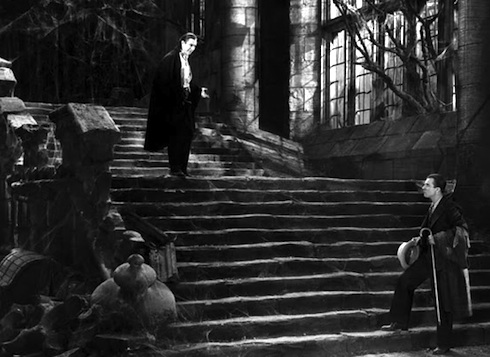
The plot of Dracula starts off pretty innocuously. An English-speaking business man named Renfield is en route to a business meeting with Count Dracula in Castle Dracula; which everyone tells him is a really stupid idea because Dracula’s a vampire. Renfield already looks pale and drained of blood and even if you weren’t aware of what kind of movie this was, you’d know this guy was going to get screwed with pretty quickly. Meanwhile, in Castle Dracula, Drac and his three vampire wives are just getting out of their coffins. (The first vampire we see is actually one of his wives, and not the Count himself.)
Dracula acquires a piece of property in London where he plans to move, and Renfield is basically there to have him sign the contract. We get the impression that Count Big D kills Renfield, and the next thing you know, the movie has shifted to a boat heading for London. But what’s this? All the sailors have been mysteriously murdered by having all the blood drained from their bodies? I get the impression here that it’s been a long time since Dracula has had a steady supply of blood, which may account a little for his halted speech. The guy is super dizzy, probably because he skips meals for centuries at a time! Give him a second to get it together. He’ll talk. But. Very. S-l-o-w-l-y.
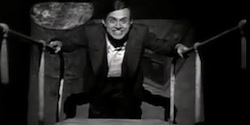 The only survivor aboard the ship is Fritz Renfield! Renfield the real estate agent has somehow been turned into a sort of halfway vampire who is doing Dracula’s daytime dirty work. The actor who plays Renfield is named Dwight Frye and he totally steals the show. When you see him perched on Dracula’s coffin, whispering creepy sweet-nothings of allegiance, it’s hard to believe this is the same guy who just showed up at Castle Dracula a few moments before. Later in the film, when Renfield is committed to an institution, he rants about Dracula gifting him with a bunch of rats, which becomes a speech that puts the creep firmly back into creepy.
The only survivor aboard the ship is Fritz Renfield! Renfield the real estate agent has somehow been turned into a sort of halfway vampire who is doing Dracula’s daytime dirty work. The actor who plays Renfield is named Dwight Frye and he totally steals the show. When you see him perched on Dracula’s coffin, whispering creepy sweet-nothings of allegiance, it’s hard to believe this is the same guy who just showed up at Castle Dracula a few moments before. Later in the film, when Renfield is committed to an institution, he rants about Dracula gifting him with a bunch of rats, which becomes a speech that puts the creep firmly back into creepy.
But the true star of Dracula is the smooth talking, slickly dressed Lugosi. In my Frankenstein movie rewatch, I talked a little bit about how Karloff was able to convey a range of emotions from a simple glance. Lugosi is able to perform similar feats, but with a different result. His gaze communicates “I want to suck your blood” but also “and you’re going to like it!” When he shows up in London, Dracula proceeds to crash a night at the theatre and starts making the moves on the ladies. In particular he’s interested in Miss Mina (Helen Chandler), though Mina’s friend Miss Lucy (Frances Dade) has the hots for Dracula just a little bit more. Soon after Dracula chats them up, the women are combing their hair and gossiping about how great Dracula is. Mina mentions she wants someone more “normal” to which Lucy dismissively says, “Like John?”
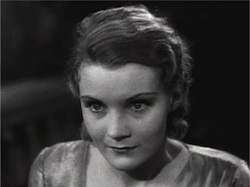 I like this a lot, because it’s emblematic of the best aspects of old monster movies. The monster is the star, and in this case, also the sex symbol. The white bread boy character, John (David Manners), isn’t nearly as cool or interesting as Dracula. This guy is a bro of the same ilk as Jack from King Kong, meaning these two should just get their own movie where they play flip-cup and play fantasy football. That would free the movie up from having to be saddled with a traditional hero, and then maybe Dracula would win! There’s a great scene towards the end when Mina — partially under Dracula’s power — tells John that “it’s all over.” The finality of her tone has the shadow of a real break-up, and for a second the notion that Mina actually wants to be with Dracula, and not John, is subtly asserted.
I like this a lot, because it’s emblematic of the best aspects of old monster movies. The monster is the star, and in this case, also the sex symbol. The white bread boy character, John (David Manners), isn’t nearly as cool or interesting as Dracula. This guy is a bro of the same ilk as Jack from King Kong, meaning these two should just get their own movie where they play flip-cup and play fantasy football. That would free the movie up from having to be saddled with a traditional hero, and then maybe Dracula would win! There’s a great scene towards the end when Mina — partially under Dracula’s power — tells John that “it’s all over.” The finality of her tone has the shadow of a real break-up, and for a second the notion that Mina actually wants to be with Dracula, and not John, is subtly asserted.
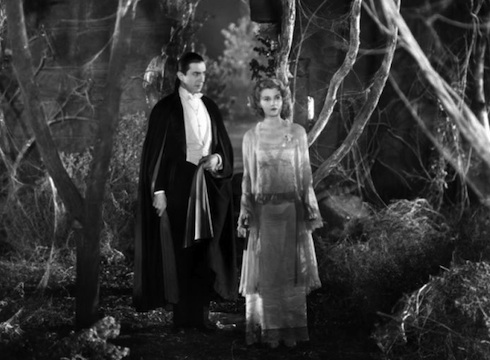
Whenever the camera zooms in on Dracula you’re reminded of just how alluring a monster movie you’re watching. Though Philip Glass retroactively recorded a fitting score in 1998 for Dracula, the almost silent quality to some of these initial shots contributes to making the movie cool in an understated way. Lugosi’s Dracula is creepy when he interacts with normal people, but oddly charming, too. He knows that you know he’s totally weird and is subtly mocking you for not being as cool as he is. Dracula is also the best-dressed dude in the movie, owing primarily to the fact that his pants fit properly.
Mina also gets a few wonderfully chilling lines, particularly one where she talks about how Dracula “opened his veins” in order to convert her. The most gruesome images in Dracula are never depicted on screen, making the potential for what this monster can do the thing to be truly afraid of. Notably, there’s not a single scene in this movie where Dracula bears his vampire fangs.
But he doesn’t need them because Lugosi and the movie he inhabits are already charming us to death.
Ryan Britt is the staff writer for Tor.com.










